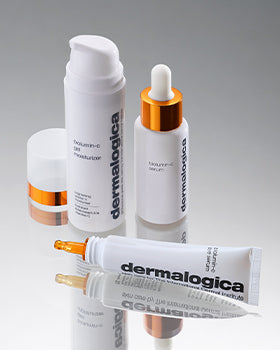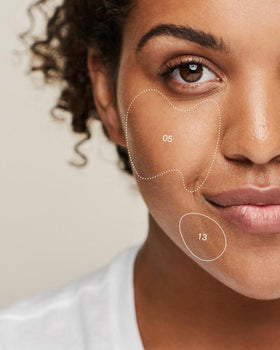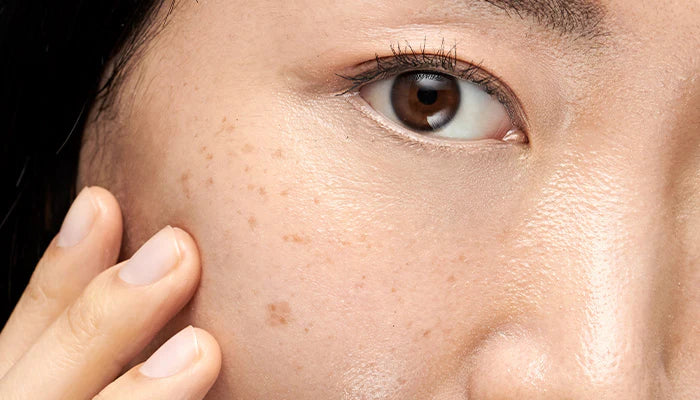Brown spots have a major influence on how old people think we are. In fact, one study showed that unbalanced skin tone can make a person look more than 12 years older! The big questions: where do they come from, and what can you do about them?
It helps to understand the science behind brown spots. The official term for brown spots and other forms of skin discoloration is hyperpigmentation. Unlike freckles, hyperpigmentation doesn’t fade in winter and, unfortunately, it becomes more visible as we age.
how is uneven skin tone caused?
Sun exposure: When your skin is repeatedly exposed to UV light, sun damage occurs. Brown spots and uneven skin tone develop as a result of too much melanin being produced, to help protect your skin from UV light.
Pollution: New research indicates that airborne pollution particles that become lodged deep in the skin, oxidises the surrounding tissue causing irritation that leads to uneven pigmentation. Rising levels of airborne soot and traffic-generated pollution cause a 20-25% increase in dark spots - adding up to 20 years to your perceived age!
Hormones: Melasma is a hormone-related hyperpigmentation caused by increased hormone stimulation. It's most commonly experienced by women who are pregnant (which is why it's also known as the "mask of pregnancy") or taking contraceptives, but can also be a reaction to cosmetics or medications.
Post-Inflammatory Hyperpigmentation (PIH): This type of dark spot is the result of inflammation or injury to theskin (for example, from acne, deep cuts or burns.) Susceptibility to PIH typically increases with age, as cell turnover slows with age, and it takes dark spots typically longer to move to skin's surface and slough off.
So, what to do about it? Here’s how to take action against your brown spots.
apply spf daily
Unprotected sun exposure is the number one culprit behind hyperpigmentation. Applying a sunscreen or moisturiser with a Broad Spectrum SPF of at least 30, is the easiest way to help prevent new dark spots and it also helps control the colour intensity of the spots you can see. Wear it daily to make the most of the treatments you try. 30 minutes of unprotected sun exposure can undo a month's worth of effort in fighting hyperpigmentation. PRO Tip: Try our PowerBright Moisturizer SPF50 for protection and treatment of pigmentation.
exfoliate regularly
Exfoliation is the perfect way to treat existing hyperpigmentation by first sloughing off dead, dulling skin cells at the surface. This clears the path for the ingredients in your serums and moisturisers to better penetrate the skin. PRO Tip: Look for a skin peel that includes skin brightening actives and acids whilst minimising irritation, such as PowerBright Dark Spot Peel.
acively treat pigmentation
Often referred to as "Tyrosinase inhibitors", treatments for fading dark spots, typically contain ingredients that inhibit the causes of excess pigment production. One of the main culprits is Tyrosinase: an enzyme that's a key ingredient in making pigment. PowerBright Dark Spot Serum is formulated with high-tech ingredients, such as Hexylresorcinol and Niacinamide, the work together to reduce excess pigment in the skin. Hexylresorcinol can supress Tyrosinase activity, whilst Niacinamide helps prevent the transfer of pigment to our skin cells. You'll also find these actives in PowerBright Overnight Cream - a nighttime moisturiser for an around the clock treatment, fading dark spots while you sleep.
As one of the most potent antioxidants available, Vitamin C is highly effective at scavenging free radicals. It also helps your skin to defend itself against future oxdidative stress - effectively brightening skin from the inside out. Just to make sure to choose a Vitamin C formula that's both ultra-stable and highly bioavailable like BioLumin-C Serum
be patient
There’s no quick fix for hyperpigmentation: depending on how deep your pigmentation is in the skin, it can take some time before you see progress. Additionally, some spots may look darker before they lighten; this is because they gradually rise to the skin’s surface as you continue to exfoliate. But stick with it, and you’ll eventually see fewer dark spots and brighter, firmer, more radiant skin overall!
Kickstart your battle against dark spots by speaking to a Dermalogica professional skin therapist, for a complimentary FaceMapping skin analysis. They will hone in on what's causing your dark spots and recommend a personalised plan of action. Tying in a professional series of treatments, such as Pro Power Peels, which will help expedite results.



